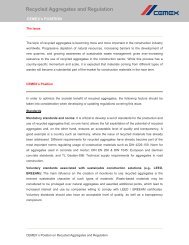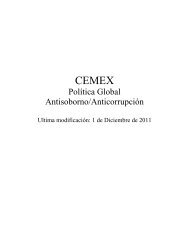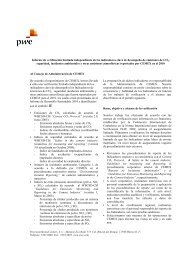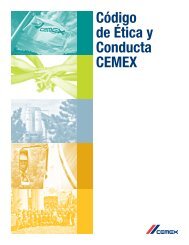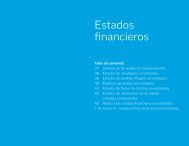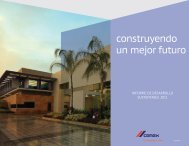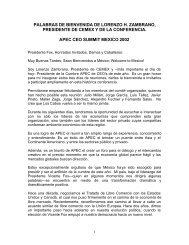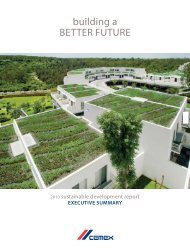building a STRONGER foundation - Cemex
building a STRONGER foundation - Cemex
building a STRONGER foundation - Cemex
Create successful ePaper yourself
Turn your PDF publications into a flip-book with our unique Google optimized e-Paper software.
(l) U.S. GAAP adjustments to discontinued operations<br />
CEMEX, S.A.B. DE C.V. AND SUBSIDIARIES<br />
Notes to the Consolidated Financial Statements – (Continued)<br />
As of December 31, 2010, 2009 and 2008<br />
(Millions of Mexican pesos)<br />
The reconciling items in the reconciliation of net income (loss) to U.S. GAAP related to CEMEX’s operations in Australia for the years ended<br />
December 31, 2009 and 2008 were as follows:<br />
2009 2008<br />
Interest expense 1.......................................................................................................................... Ps (373) (388)<br />
Income tax 2.................................................................................................................................. 109 113<br />
U.S. GAAP adjustments from discontinued operations .......................................................... Ps (264) (275)<br />
1 Represents the interest related to the repaid debt with the proceeds of the sale of our Australian operations, required to be allocated to discontinued<br />
operations by IASC 205-20-45-6 “Reporting Discontinued Operations”.<br />
2 Income tax effects related to the interest mentioned in footnote 1 above.<br />
Discontinued operations financial expense<br />
According to ASC 205-20-45-6, Reporting Discontinued Operations - Allocation of Interest to Discontinued Operations, and in connection<br />
with the sale of the Australian operations (note 3B), interest on debt that is to be assumed by the buyer and interest on debt that is required to<br />
be repaid as a result of a disposal transaction shall be allocated to discontinued operations. The amounts of interest expense reclassified to<br />
discontinued operations related to the repaid debt with the funds received from the sale of our subsidiary in Australia for the years ended<br />
December 31, 2009 and 2008 were Ps373 and Ps388, respectively. This interest expense was reclassified net of its tax effect for<br />
approximately Ps109 in 2009 and Ps113 in 2008, and is included within income from discontinued operations. CEMEX elected not to<br />
reclassify other interest expenses which are not directly attributable to discontinued operations, as permitted under ASC 205-20.<br />
(m) Supplemental Cash Flow Information under U.S. GAAP<br />
Beginning in 2008 under MFRS (note 2A), as part of its primary financial statements, CEMEX includes statements of cash flows, which<br />
present the sources and uses of cash flows in following significantly the same requirements as those established by ASC 230, Statement of<br />
cash flows, under U.S. GAAP, instead of the statement of changes in financial position presented until December 31, 2007 which identified<br />
the sources and uses of resources based on the differences between beginning and ending balance sheets in constant pesos.<br />
MFRS requires interest expense to be classified as a financing activity within the statement of cash flows, unlike ASC 230 under U.S. GAAP,<br />
which requires it to be classified as an operating activity. The following table presents cash flows from operating, financing and investing activities<br />
under MFRS and U.S. GAAP pursuant to the reclassification of interest expense for the years ended December 31, 2010, 2009 and 2008:<br />
2010 2009 2008<br />
MFRS U.S. GAAP MFRS U.S. GAAP MFRS U.S. GAAP<br />
Cash flows provided by operating activities ................ Ps 21,838 6,009 34,751 20,144 41,272 29,488<br />
Cash flows used in financing activities........................ (24,387) (8,558) (37,146) (22,539) (23,689) (11,905)<br />
Cash flows provided by (used in) investing activities.. (1,862) (1,862) 5,715 5,715 (14,630) (14,630)<br />
Non-cash activities during 2010, 2009 and 2008 are disclosed in note 2A.<br />
(n) Sales of accounts receivable<br />
In December 2009, the FASB issued ASU 2009-16, Transfers and Servicing (Topic 860): Accounting for Transfers of Financial Assets (FASB<br />
Statement No. 166, Accounting for Transfers of Financial Assets – an amendment of FASB Statement No. 140) (“ASU 2009-16”). ASU 2009-16<br />
removes the concept of a qualifying special purpose entity (“QSPE”) from ASC Topic 860, Transfers and Servicing, and the exception from applying<br />
ASC 810 10 to QSPEs, thereby requiring transferors of financial assets to evaluate whether to consolidate transferees that previously were considered<br />
QSPEs. Transferor imposed constraints on transferees whose sole purpose is to engage in securitization or asset backed financing activities are<br />
evaluated in the same manner under the provisions of ASU 2009-16 as transferor imposed constraints on QSPEs were evaluated under the provisions<br />
of Topic 860 prior to the effective date of ASU 2009-16 when determining whether a transfer of financial assets qualifies for sale accounting. ASU<br />
2009-16 also clarifies the Topic 860 sale accounting criteria pertaining to legal isolation and effective control and creates more stringent conditions for<br />
reporting a transfer of a portion of a financial asset as a sale. ASU 2009-16 was effective for CEMEX beginning January 1, 2010.<br />
Until December 31, 2009, CEMEX accounted for transfers of receivables under MFRS consistently with the rules set forth by ASC 860,<br />
Transfers and Servicing (“ASC 860”). Under ASC 860, transactions that met the criteria for surrender of control were recorded as sales of<br />
receivables and their amounts were removed from the consolidated balance sheet at the time they are sold (note 5). ASC 860-50-30, Transfers<br />
and Servicing - Servicing Assets and Liabilities - Initial Measurement, requires that all separately recognized servicing assets and servicing<br />
liabilities be initially measured at fair value, if practicable. ASC 860-50-35, Transfers and Servicing – Servicing Assets and Liabilities –<br />
Subsequent Measurement, permits, but does not require, the subsequent measurement of servicing assets and servicing liabilities at fair value. An<br />
entity should apply the requirements for recognition and initial measurement of servicing assets and servicing liabilities prospectively to all<br />
similar transactions. For the years ended December 31, 2010, 2009 and 2008, CEMEX did not determine any reconciling item resulting from<br />
servicing assets and liabilities under U.S. GAAP considering that the effects were immaterial. In arriving at this conclusion CEMEX considered<br />
that the receivables are short-term financial assets with an average collection period of approximately 42 days, and assumed a 1% servicing fee<br />
over its approximately US$807 and US$735 of receivables sold under MFRS at December 31, 2010 and 2009, respectively. The result is a<br />
servicing asset of approximately US$8 in 2010 and US$7 in 2009 that would be amortized every 42 days.<br />
F-77



